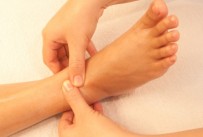Some factors of foot pain

Some factors of foot pain
Written by: Paul Kochoa, PT, DPT, OCS, CKTP, CGFI
In an issue of Journal of Orthopedic & Sports Physical Therapy, an article reported on the biomechanical and clinical factors of posterior tibial tendon dysfunction (PTTD). They studied 24 individuals with and without foot pain or PTTD. What were the differences? They found several factors related to foot arch height and rearfoot kinematics that made the difference between having foot pain or not. Other points of the study that didn’t make a difference was foot inversion strength, foot rigidity, and standing arch height. The study found that subjects with PTTD had lower seated arch height and more rearfoot eversion during gait. What does all that mean to you? It can reveal if you are at high risk of developing PTTD and how you can prevent it.
First, the bottom line of the study was that individuals with increased pronation were at high risk of developing PTTD. Pronation is another term used to describe when your arch flattens and your foot rolls inward into a flatter position. Rearfoot eversion is a component of pronation, it’s when the heel bone also collapses inward. The posterior tibialis muscle is a long, thin muscle that lies beneath the bigger calf muscles. It sits on the medial side of the lower leg (the inside calf area), and wraps around the ankle bone and dives down into the underside of the foot. Contraction of this muscle makes the foot point inward and curls the arch of the foot up. This means that the action of the posterior tibialis muscle is the opposite to the foot direction and structure that precedes PTTD, foot pronation and a lowered arch.
So the constant, repeated pronation of the foot when you stand up puts a strain on the posterior tibialis muscle, and over time, can cause it to become inflamed and become dysfunctional. However, the posterior tibialis muscle is only half the equation. The study also found that foot inversion strength had no correlation with PTTD, which means that it’s not just the posterior tibialis muscle weakness that could cause PTTD. Biomechanically, there are other static structures that support the arch of the foot that may need to be addressed as well.
But one thing that you can do is address the tension or tightness in the posterior tibialis muscle and its tendon to prevent PTTD. Remember to stretch the calf and Achilles tendon complex and use some soft tissue mobilization to the posterior tibialis muscle and tendon to further loosen it up and prevent any tissue adhesion. Also, make sure you consult your physiotherapist to do a complete evaluation if you have any questions. Don’t self treat blindly.
If you would like more information, please call Professional Physical Therapy and Training at 973-270-7417. Our offices are located within the YMCA locations in Madison and Summit, NJ. You do not need to be a member of the YMCA to visit with us.
